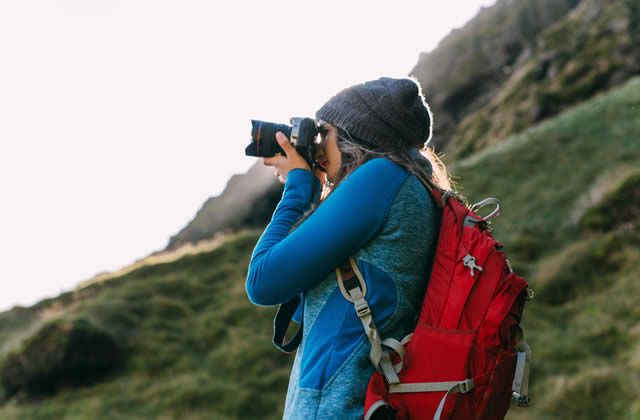Whether you’re strolling through bustling city streets, hiking rugged mountain trails, or enjoying a serene beach, capturing beautiful photos can bring your travel memories to life. With a few simple techniques, you can make the most of any scene, ensuring your vacation photos are as vibrant and captivating as the memories themselves. Here are some expert travel photography tips to help you snap stunning shots every time.
Know Your Gear (But Keep It Light)
Why It Works: Familiarizing yourself with your camera or smartphone’s features helps you capture images quickly and effectively. But there’s no need to pack every lens or accessory you own—travel photography is often about mobility.
How to Do It: Practice with your camera before your trip. Learn how to adjust exposure, focus, and zoom so you’re ready for different lighting and compositions on the go.

Consider the Golden Hours
Why It Works: The golden hours—just after sunrise and before sunset—offer soft, warm lighting that’s perfect for photography. It minimizes harsh shadows and highlights, making landscapes and portraits look more natural.
How to Do It: Aim to start shooting early in the morning or just before sunset. Set an alarm or plan your day around these times to take advantage of the soft light, especially for landscape shots.

Focus on Composition
Why It Works: Thoughtful composition makes a big difference in travel photography. It’s about how you frame the scene to draw the viewer’s eye and create balance.
How to Do It: Use the rule of thirds—imagine dividing your frame into nine equal parts, and position your main subject along these lines or at the intersections. This technique helps create a more balanced and visually appealing image.

Capture Local Culture and Details
Why It Works: Photographing unique details, such as local architecture, traditional foods, or cultural landmarks, brings a destination’s story to life and adds variety to your collection.
How to Do It: Look beyond the big landmarks and capture the small details that make a place unique. For example, photograph market stalls, local attire, or even street signs that highlight the essence of the location.

Play with Perspectives and Angles
Why It Works: Unique angles can make your photos stand out and add an artistic flair to your shots. Experimenting with high or low angles helps you see familiar scenes in a new way.
How to Do It: Try taking photos from a lower angle for buildings or landmarks, or climb to a higher viewpoint for a panoramic shot. Don’t be afraid to move around or tilt your camera to capture the best perspective.

Include People for Scale and Context
Why It Works: Adding people to your shots gives viewers a sense of scale, especially for large landmarks or vast landscapes. It also adds a human element, making the scene feel more relatable.
How to Do It: Include yourself, friends, or even local residents in your shots. For instance, a person standing at the edge of a cliff or in front of a towering mountain gives a sense of the location’s grandeur.

Use Leading Lines
Why It Works: Leading lines guide the viewer’s eye through the image, making the photo more dynamic. Natural lines like roads, rivers, or even pathways help create depth and movement.
How to Do It: Frame your shots to include paths, fences, or rivers that lead toward the main subject. This technique is especially effective in landscape and cityscape photography.
Adjust to the Weather
Why It Works: Different weather conditions add mood and uniqueness to your photos. Cloudy skies, rain, or mist can enhance a scene and create a specific atmosphere that’s memorable.
How to Do It: Embrace the weather, even if it’s not sunny. Misty landscapes, reflections on rainy days, or dramatic clouds can make for incredible shots. Adjust your settings to capture these conditions effectively.

Experiment with Night and Low-Light Photography
Why It Works: Nighttime photography opens up a world of new possibilities, especially in cities where buildings, streets, and monuments are lit up.
How to Do It: Use a tripod to keep your camera stable for longer exposures in low light. Play with settings like ISO and exposure time to capture the best night shots. Some smartphone cameras also have night modes that can help with handheld shots.

Edit Thoughtfully
Why It Works: Post-editing lets you enhance colors, sharpness, and brightness for more polished photos. Small tweaks can elevate your travel photos from good to great.
How to Do It: Use editing apps like Lightroom or Snapseed to make adjustments. Don’t go overboard; aim for a natural look that stays true to the original scene while highlighting the best aspects of the photo.

Final Thoughts
Capturing beautiful travel photos is a skill that can make your vacation memories last a lifetime. With a bit of preparation, a creative approach to composition, and a willingness to experiment, you can turn any scene into a stunning image. So pack your camera, hit the road, and let your photos tell the story of your adventure in a way words alone never could.



